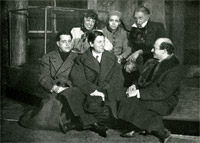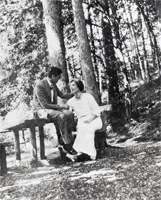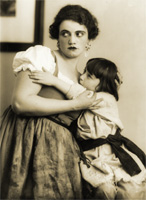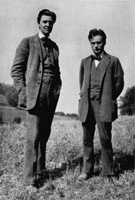 Alban Berg, along with his mentor Arnold Schoenberg and fellow pupil Anton Webern, was a principal composer of the Second Viennese School. The Second Viennese School thrived before World War One, and is now best known for breaking with tonality and creating serial composition. The composers of this school theoretically inherited their legacy from a “First Viennese School” (Mozart, Haydn, and Beethoven), although these earlier composers were by no means as closely associated with one another as were those of the Second School. Coincidentally, the deaths of Berg, Schoenberg, and Webern were all somewhat unusual. In Berg’s case, he was stung by an insect, which led to an abscess and blood poisoning. He died on Christmas Eve, 1935. Alban Berg, along with his mentor Arnold Schoenberg and fellow pupil Anton Webern, was a principal composer of the Second Viennese School. The Second Viennese School thrived before World War One, and is now best known for breaking with tonality and creating serial composition. The composers of this school theoretically inherited their legacy from a “First Viennese School” (Mozart, Haydn, and Beethoven), although these earlier composers were by no means as closely associated with one another as were those of the Second School. Coincidentally, the deaths of Berg, Schoenberg, and Webern were all somewhat unusual. In Berg’s case, he was stung by an insect, which led to an abscess and blood poisoning. He died on Christmas Eve, 1935.
Berg’s Formative Years
Alban Berg was born into an affluent Viennese family on February 9, 1885. His father, Conrad Berg, ran a successful export business and owned properties throughout Vienna, as well as an estate in Carinthia known as the Berghof. As practicing Catholics, the Berg family also garnered income from a shop Berg’s mother Johanna operated, a Devotionalienhandlung. However the family faced financial difficulties when Berg’s father died in 1900.
For Berg the loss of his father was unfortunate on a very practical level. As a pupil, Berg was notoriously lazy, and, due to poor academic performance, his future career choices were limited, particularly as the family finances were unstable. Having graduated from Gymnasium after repeating two years, Berg found himself working as a trainee civil servant.
He was rescued from this career in October of 1904 when his siblings interfered and secured him a position as Arnold Schoenberg’s private pupil. Before formally becoming a composition student, Berg had written approximately eighty songs and a number of piano duets; these compositions were composed for performance at home where all the children had been taught to play the piano by the governess. The early songs reflected the Romantic sensibility of Brahms, Debussy and Schumann.
Studies with Arnold Schoenberg

Schoenberg’s first order of business was to address what he considered to be Berg’s biggest weakness: his inability to compose instrumentally. To his new teacher, Berg seemed capable only of composing vocal lines. Consequently, the teacher set the pupil on a rigorous course of study, which included instruction in harmony, strict counterpoint and the principles of large and small compositional construction. Schoenberg not only oversaw Berg’s musical studies, he also advised him in other facets of life, such as dress and personal character.
The works that date from this period include the Sieben frühe Lieder (1905-1908), the Piano Sonata op.1, the Vier Lieder op.2 and the String Quartet op.3. The first two are considered Romantic and the last two atonal. Perhaps the most important idea that Berg took from his studies with Schoenberg was that of “developing variation,” an idea which states that a piece is held together by the thorough development of a single basic idea. Berg held onto this compositional strategy throughout his career and conveyed it to his own students, among whom was Theodor Adorno the famous German philosopher and critical theorist.
As Berg pursued his studies he took in the cultural atmosphere of turn-of-the century Vienna. As the geographic center of a dominant world power, the Austro-Hungarian Empire, the city’s intellectual environment both attracted and produced great thinkers of the time. Among them, Karl Kraus perhaps had the greatest impact on Alban Berg.
Karl Kraus is today considered something of a prophet, having accurately assessed the cultural and political climate of early twentieth-century Vienna and thus having envisaged events such as the two World Wars and the dissolution of the empire. His pronouncements, made via a newspaper, were closely followed and adhered to by segments of Viennese intelligentsia. The same can be said of his thoughts on the creative arts. Kraus was actively involved in supporting artists and works that he believed needed assistance. He was particularly drawn to the playwright Frank Wedekind (1864-1918), whose play Die Büchse der Pandora had been banned by the authorities as obscene. Kraus organized two private performances of this play in 1905. Berg attended one of them and was attracted to the work. Several years later he based his opera Lulu on this play.
After seven years of lessons with Schoenberg, in 1911 Berg ended his formal study when the former departed for Berlin. Throughout Berg’s life, Schoenberg was to remain an important influence and even a father figure, a relationship that is revealed in the sometimes-obsequious letters that Berg wrote to his former teacher. The years that Berg studied with Schoenberg are considered the start of the Second Viennese School, which also included Schoenberg’s other pupil Anton Webern.
Marriage and Scandal
 The year that Berg left Schoenberg is the same year in which he married Helene Nahowski. The courtship of Helene had been a long and difficult one because her father did not approve of the match. It is probable that Franz Nahowski, Helene’s father, objected to Alban Berg on two grounds: his Catholic faith and that he was largely unemployed. Ultimately Berg was able to convince Helene’s father to allow them to marry, in part because he converted to Protestantism; however, after the marriage he returned to Catholicism. The year that Berg left Schoenberg is the same year in which he married Helene Nahowski. The courtship of Helene had been a long and difficult one because her father did not approve of the match. It is probable that Franz Nahowski, Helene’s father, objected to Alban Berg on two grounds: his Catholic faith and that he was largely unemployed. Ultimately Berg was able to convince Helene’s father to allow them to marry, in part because he converted to Protestantism; however, after the marriage he returned to Catholicism.
The year following Schoenberg’s departure, Berg wrote Fünf Orchesterlieder nach Ansichtkartentexten von Peter Altenberg (Five Orchestral Songs after Picture Postcard Texts by Peter Altenberg) op.4. At the first performance of these songs on March 31, 1913, there was a riot due to what was considered offensive poetry. The police were called in and arrested the concert organizer. This performance, one of the great scandals in Western music history, was conducted by Schoenberg and also included works by himself, Webern, Zemlinsky and Mahler. Schoenberg harshly criticized the piece by Berg, not on account of its scandalous nature but instead because of its brevity, and as a result Berg chose neither to publish it nor to have it performed during his lifetime.
Wozzeck
In 1914, Berg once again decided to set controversial material after seeing a performance of Georg Büchner’s play Woyzeck, the story of a soldier who is tormented by his superiors and ultimately kills himself and his mistress Marie. The play may have resonated with Berg because of his own life experiences. First, shortly after his father’s death, Berg fathered an illegitimate child with a Berghof kitchen maid named Marie. Second, his time in the army during the First World War may have also influenced him as he was working on the opera.
 From 1917 to 1922, Berg worked on this expressionist opera, called Wozzeck, and upon completion was forced to publish it himself by borrowing the money from his sister Smaragda. Not long after, Alma Mahler assisted him in repaying the loan and hence the score is dedicated to her. Having the opera produced, however, proved even more difficult. Despite thorough marketing efforts on his part, no opera company would stage the work, deeming it too complex (it is considered the first fully atonal opera) and not wanting to take a risk on a fairly unknown composer. From 1917 to 1922, Berg worked on this expressionist opera, called Wozzeck, and upon completion was forced to publish it himself by borrowing the money from his sister Smaragda. Not long after, Alma Mahler assisted him in repaying the loan and hence the score is dedicated to her. Having the opera produced, however, proved even more difficult. Despite thorough marketing efforts on his part, no opera company would stage the work, deeming it too complex (it is considered the first fully atonal opera) and not wanting to take a risk on a fairly unknown composer.
However, in 1924 this situation changed when, after having parts of Wozzeck performed as a concert suite, Erich Kleiber, the music director of the Berlin Staatsoper, decided to stage the full work. Thus, in December 1925 the opera received its premiere and Berg began to achieve critical and popular success.
Following the opera Berg wrote the Kammerkonzert for violin, piano and thirteen wind instruments and the Lyrische Suite (1927) for string quartet. It was with these pieces that he fully embraced twelve-tone composition. In addition, the Kammerkonzert is Berg’s first instrumental piece to fully utilize extramusical programmatic ideas. He centered these ideas on the three main composers of the Second Viennese School: Schoenberg, Webern, and himself. Works following this one also have such internal programmatic ideas. For instance, in the Lyrische Suite the extramusical material concerns the affair between Berg and Hanna Fuchs-Robettin, a married woman.
Lulu

In 1928, Berg returned to the material that had caught his attention almost twenty years beforehand. This material consisted of the Lulu plays by Wedekind, which dealt with the subject of sexual hypocrisy. Again, Berg probably was drawn to this material for personal reasons. First, there was his affair with the maid. Second, the topic of sexual morality, particularly that of men versus women, wherein men were permitted indiscretions and women of a certain class were expected to remain virgins until married, was keenly debated in the Vienna of Sigmund Freud. And third, Berg may have also been interested in questioning the prevailing sexual code because his sister Smaragda, who, not long after making an advantageous marriage, declared that she was gay.
His work on this opera, called Lulu, lasted from 1928 to 1935. The opera was a twelve-tone work and was also an example of expressionism in music. Because of his frequent travel to oversee performances of his works and simultaneous work on new pieces, the opera’s completion took quite some time. During these years, the Nazis came to power and, as a result, performances of his compositions decreased as the Nazis judged them to be the work of a “cultural Bolshevik.”
In 1935 he was close to completely scoring Lulu and had also written the Violin Concerto. Louis Krasner, a violinist, commissioned the latter and Berg wrote it as a memorial to Manon Gropius, the daughter of Alma Mahler and Walter Gropius who had recently died. In November of that year an insect stung him. This sting formed an abscess that ultimately caused his death on December 24, 1935.
Lulu, which had all but some of the third act scored, was premiered in Zurich in 1937 with its first fully-scored two acts and act three being completed with the final Adagio of his Symphonische Stücke aus ‘Lulu.’ His widow, Helene, never allowed its complete scoring during her lifetime and thus, it was not until after her death in 1976 and a court battle with the Berg estate, that Friedrich Cerha, an Austrian composer, finished the score. It received its premiere as a completed work in Paris in 1979.
-- Eve McPherson
References:
Berg, Alban. Alban Berg: Letters to his Wife. Ed. and Trans. Bernard Grun. New York: St. Martin’s Press, 1971.
Brand, Juliane, Christopher Hailey and Donald Harris, eds. The Berg-Schoenberg Correspondence. New York: W.W. Norton and Company, 1987.
Crawford, John and Dorothy Crawford. Expressionism in Twentieth-Century Music. Bloomington, IN: Indiana University Press, 1993.
Esslin, Martin. “Berg’s Vienna.” The Berg Companion. Ed. Douglas Jarman. London: MacMillan Press, 1989. 1-12.
Franklin, Peter: ‘Mahler(-Werfel) [née Schindler], Alma Maria’, Grove Music Online ed. L. Macy (Accessed 11 August 2006), <http://www.grovemusic.com>
Jarman, Douglas: ‘Berg, Alban (Maria Johannes)’, Grove Music Online ed. L. Macy (Accessed 1 November 2004), <http://www.grovemusic.com>
Smith, Joan Allen. “Berg’s Character Remembered.” The Berg Companion. Ed. Douglas Jarman. London: MacMillan Press, 1989. 13-22. |